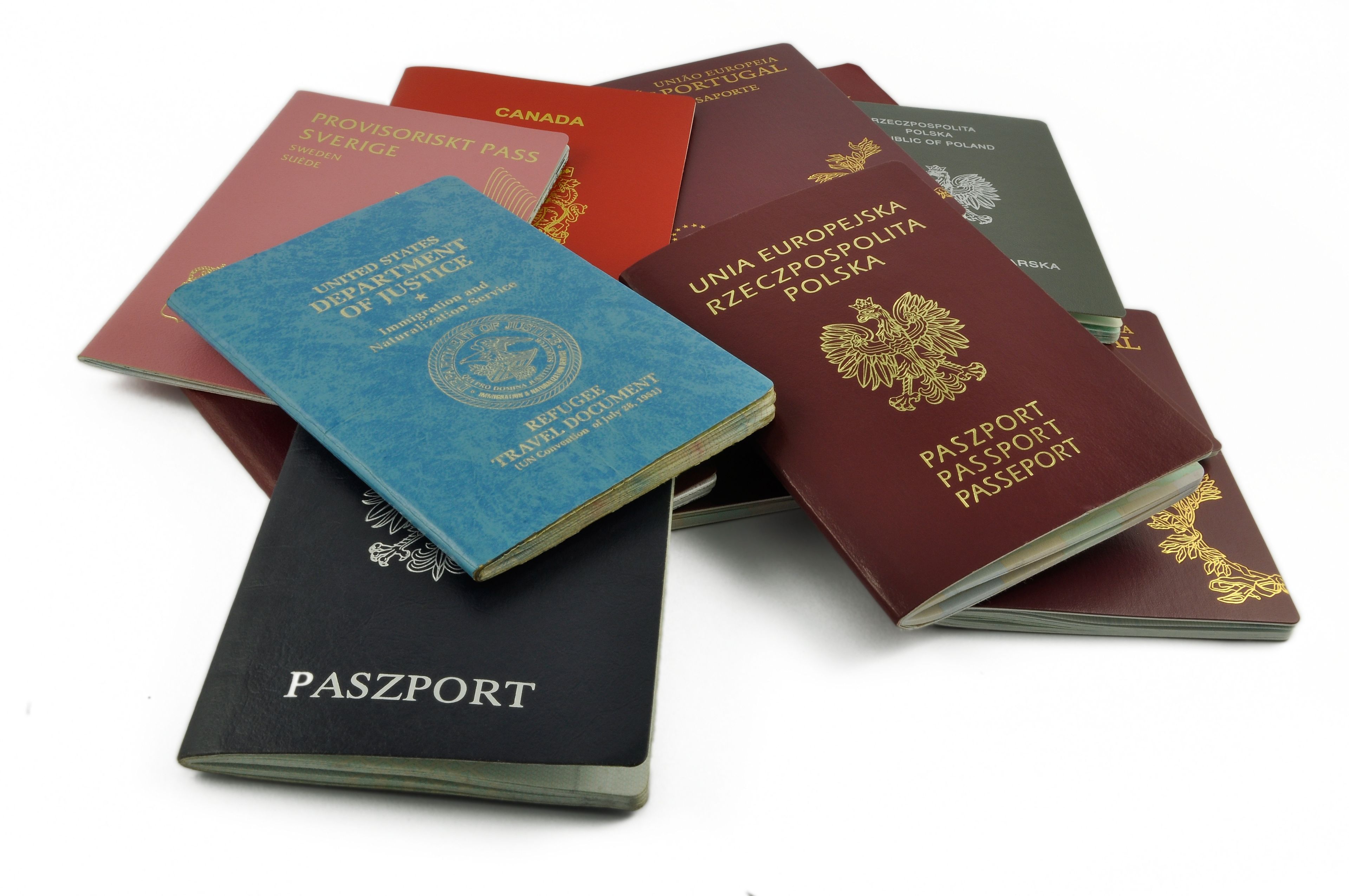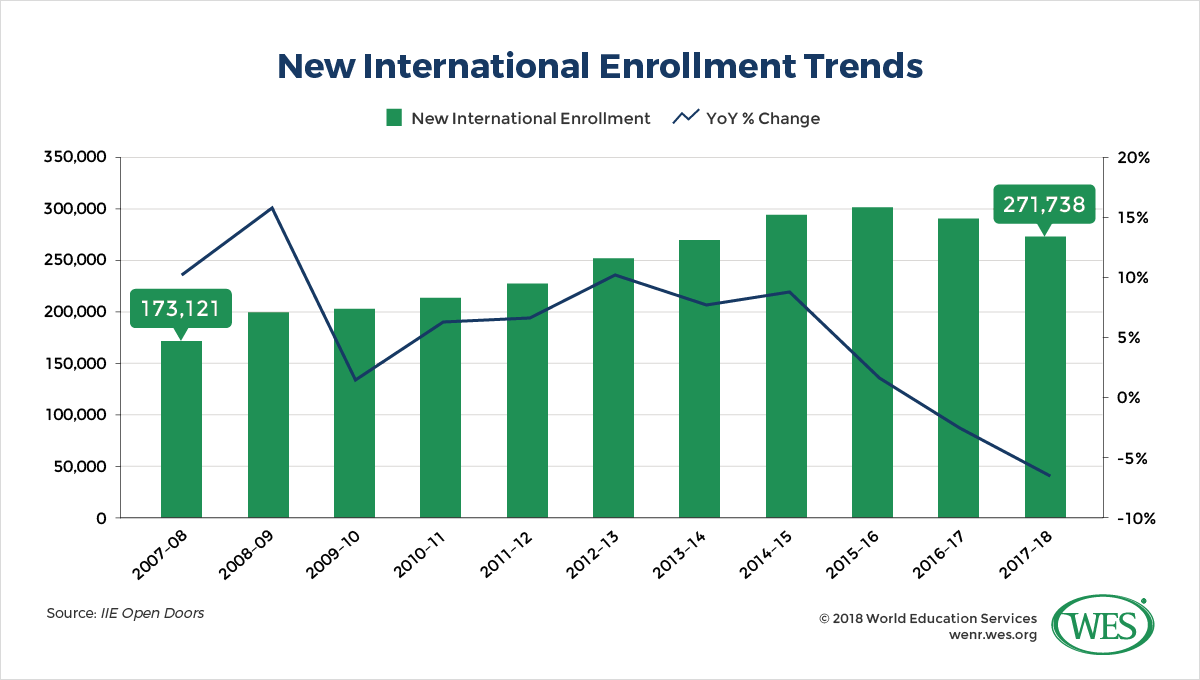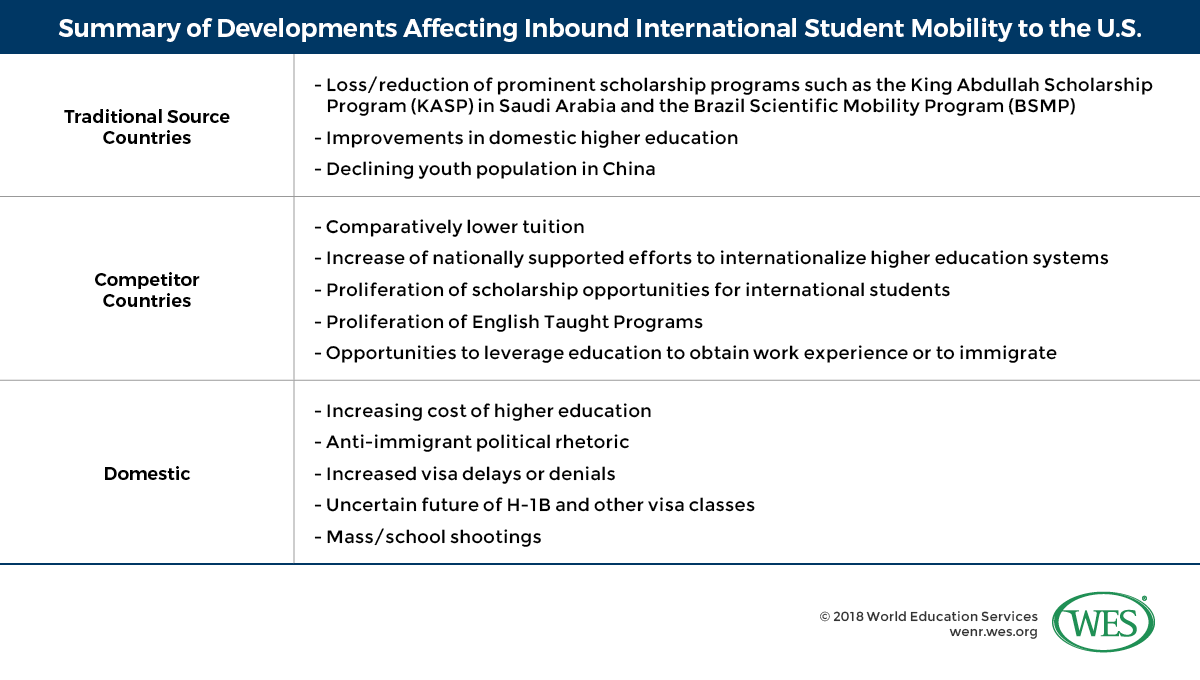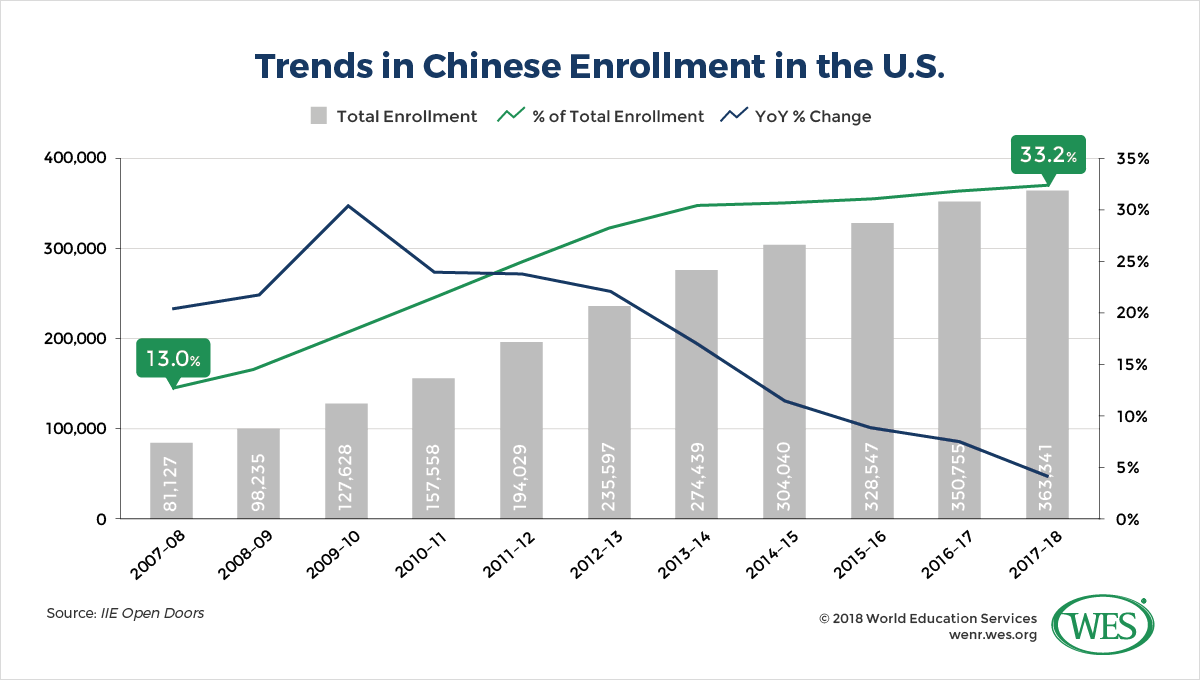
New international student enrollment at U.S. higher education institutions (HEIs) plummeted 6.6 percent for the 2017/18 academic year, doubling last year’s decline of 3.3 percent, according to new data from the Institute of International Education (IIE). Although the direction and significance of enrollment changes differ by country and academic level, the overall downward momentum is a troubling reversal of recent trends (see Figure 1).

Figure 1 New International Enrollment (IIE Open Doors Data)
Despite the fact that the two-year downward trend coincides with the 2016 election, experts and observers covering the drop almost unanimously agree that the causes are numerous and cannot be explained by the political climate alone, notwithstanding the clear impact of recent policies and rhetoric. The myriad causes of this reversal raise the question of whether current conditions can support a recovery, or if we should expect further enrollment declines.
The Complex Dynamics of International Student Mobility Into the U.S.
The flow of international students into the U.S. is a complex process influenced by conditions and developments in source countries, competition from other countries interested in increasing their own inbound mobility, and domestic U.S. policies. Although the dynamics among these factors have historically been favorable to the U.S., changes in all three have led to what I have previously referred to as a new paradigm for international student recruitment. The table below provides a summary of developments affecting international student mobility into the U.S.

While the number of international students has increased at a relatively stable clip for the last several decades, there is no reason why inbound student flows should be immune to fluctuations. Beneath the surface of the steady aggregate growth is a great diversity of factors prone to change independently of one another. For example, the King Abdullah Scholarship Program (KASP) and the Brazil Scientific Mobility Scholarship Program (BSMP) led to a large influx of international students from Saudi Arabia and Brazil until KASP was drastically reduced in 2015, and BSMP ended in 2016.
Growth from China and India—the two countries that together comprise half of all international students in the U.S.—often mitigates decreases from other individual countries. While Indian enrollment tends to fluctuate, Chinese enrollment has grown at a remarkable rate for more than a decade, helping to maintain the aggregate growth. The 28 percent decline in Saudi student enrollments during the two-year period from 2015/16 to 2017/18 resulted in a net loss of 16,855 students. Over the same period, Brazilian enrollment declined by 25 percent, a loss of 4,750 students. Concurrently, though, Chinese enrollment grew 11 percent, or 34,794 students, while Indian enrollment increased by 18 percent or 30,353 students, resulting in a net gain of international students.
As a stabilizing force in a complex system governing inbound international enrollment numbers, decreasing enrollment from China or India can have a large impact on international student numbers in the U.S. Apparent shifts in this system are already occurring. Figure 2 (below) shows three simultaneous trends for Chinese students: increasing enrollment, declining year-over-year growth, and an increasing share of Chinese students as a proportion of all international students in the U.S.

Figure 2 Chinese Enrollment Trends (IIE Open Doors Data)
Although the number of Chinese students increased this academic year, growth has slowed incrementally and consistently since 2009/10. This year’s growth of 3.6 percent is a far cry from the 29.9 percent increase of 2009/10. If these patterns persist, Chinese enrollment may soon enter a period of contraction. More troublingly, over the 10-year period shown in Figure 2, Chinese students have gone from 13 percent of all international students in the U.S. to one-third (33.2 percent)—an indication that U.S. HEIs are increasingly reliant on a source country that has, at best, only tepid growth potential.
While Indian enrollment reportedly grew 5.4 percent, student enrollments at the undergraduate and graduate levels shrank by 6.2 percent. The reported increase is the result of a 32 percent growth in Indian Optional Practical Training participation. The enrollment patterns of Indian students, who are highly conscious of both visa policy changes and their own safety, may provide the clearest indications of enrollment drops that are due to the political climate.
Adding to these concerns, the rapid and effective proliferation of internationalization efforts in other countries, and the enormous growth in the number of English Taught Programs have created a competitive international recruitment environment. In a reversal of roles, China and India are becoming major players in inbound student mobility. While growth in international students is largely the result of top-down internationalization efforts, the two countries’ relative success also attests to improvements in both the capacity and quality of their home educational systems. An interesting question is whether or when these improvements will diminish the cachet of an international degree for Chinese and Indian students.
Can the U.S. Compete in the New Paradigm for International Recruitment?
Read the full report at this link
Report by: Paul Schulmann, Associate Director of Research, WES

cheap ed medication
erectile dysfunction natural remedies pet meds without vet prescription do i have ed
buying ed pills online ed cures comparison of ed drugs
where to buy prednisone without prescription cheap prednisone 15 mg prednisone daily
anti fungal pills without prescription buy cheap prescription drugs online anti fungal pills without prescription
cheapest propecia for sale cheap propecia propecia 5 mg for sale
buy prescription drugs online prescription drugs online without doctor best online canadian pharmacy
best ed pill ed meds medication for ed
finasteride 5 mg finasteride online bonus propecia 5mga
top rated canadian pharmacies online buying from canadian online pharmacies generic drugs without doctor’s prescription
stromectol 12 mg tablets prescribing stromectol stromectol without a doctor prescription
buy clomid where to buy cheap clomid online where to buy cheap clomid online
stromectol for sale stromectol for sale stromectol without a doctor prescription
stromectol without a doctor prescription stromectol for humans for sale ivermectin without a doctor prescription
stromectol for sale stromectol 12 mg tablets stromectol without a doctor prescription
viagra pills sildenafil citrate 100mg for sale sildenafil
sildenafil citrate 100mg for sale sildenafil 100 mg viagra pills
stromectol for humans for sale stromectol 12 mg tablets stromectol for humans for sale